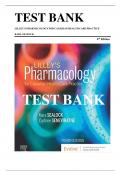Exam (elaborations)
TEST BANK LILLEY'S PHARMACOLOGY FOR CANADIAN HEALTH CARE PRACTICE KARA SEALOCK
- Course
- Institution
- Book
Chapter 01: Nursing Practice in Canada and Drug Therapy Sealock: Lilley’s Pharmacology for Canadian Health Care Practice, 4th Edition MULTIPLE CHOICE 1. Which is a judgement about a particular patient’s potential need or problem? a. A goal b. An assessment c. Subjective data d. A nursing...
[Show more]



